Whitetip
reef sharks Triaenodon obesus hovering
for a feed.
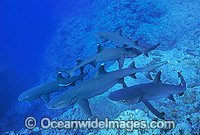
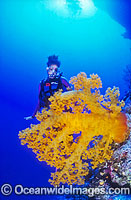
Meri exploring the Great Barrier Reef, finds
a huge yellow soft coral tree.
|
|
Obviously the sharks had done this
before; without hesitation they rushed in, tearing into
fish carcasses that had only just been tied to the coral
head. Among the frenzied pack were white-tips and grey-whalers;
the silver-tips hovered in middle distance. They were everywhere
and impossible to count.
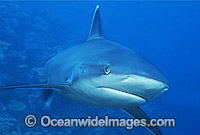
Silvertip shark Carcharhinus albimarginatus. |
|
As I moved in for a tighter shot Meri
stood by with my second camera but the sharks were oblivious
and continued as if we were invisible. Behind us was a huge
semi-circular wall dotted with twenty fascinated divers
hanging on grimly. We were diving a wellknown shark feeding
station on Osprey Reef's fabulous North Horn-' and this
was just one of many exciting dives experienced during ten
day charter out of Cairns with the Elizabeth E 11.
Our trip deliberately coincided with
the 200th Anniversary of the sinking of the Pandora and
after the Coral Sea took us to the far northern section
of the Great Barrier Reef and to places that have seen very
few divers. It was an adventure of a lifetime, bringing
divers from as far afield as Sydney, Brisbane and Mackay.
Peter Gesner, a Curatorial Officer
in the Queensland Museum's Maritime Archaeology Section,
was on board. He had not only participated in all the Museum
expeditions to the Pandora but had also logged the most
individual dive time on site. Peter's task on the Elizabeth
E II was to introduce us to the finer points of maritime
history, guide us during dives on the Pandora site and act
as "police officer" as it is an Historic Shipwreck
and fully protected by the Commonwealth Historic Shipwrecks
Act, 1976.
When we-arrived at Bougainville Reef
for the first leg, sea conditions were excellent, although
the sky was very overcast. This continued over the next
three days, allowing us to thoroughly explore the north
and north-west perimeters of both Bougainville and Osprey.
We were almost 100 nautical miles from the nearest Queensland
coast and living up to its reputation, the Coral Sea was
crystal clear.
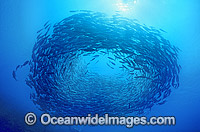
Vortex of schooling Big-eye trevally beneath
ocean surface (top).
Dogtooth tuna Gymnosarda unicolor (bottom).  |
|
Both places offered incredible diving
with sheer drop-offs plunging to unknown depths massive
coral heads and huge swim-through caverns. The fish life
was good, although not like we have seen on the Great Barrier
Reef region. Apart from the sharks, perhaps the most spectacular
of all fish was the oceanic coral trout, huge and plentiful.
We also sighted dog-tooth tuna, barracuda, mackerel and
other pelagic species along with schools of rabbit-fish,
surgeon-fish, pyramid butterfly-fish and trevally. In the
depths of Osprey's North Horn we found some large soft corals
and scattered patches of gorgonia fans and sea whips.
After North Horn, we up-anchored and
began the long haul to Great Detached Reef, about 180 nautical
miles to the north-east.
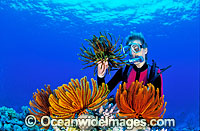
Scuba diver with crinoid featherstars (right).
Delicate rocks of 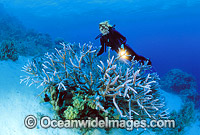 pink
staghorn were a special feature on Great
Detached Reef (left). Meri 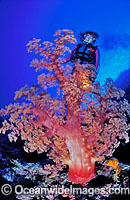 explores
a giant red soft coral tree on the Great Barrier
Reef (bottom right). These soft coral trees
tend to grow at depths where the current brings
rich nutrients. |
|
Great Detached has claimed many unsuspecting
ocean-going vessels and it wasn't long before we came across
two old anchors embedded in a holding position on the reef-flat
close to the surf. Peter Gesner suggested this site could
be that of the Aert-Van-Nes, a Dutch immigrant ship wrecked
in 1854. Everyone was ferried to the reef for a closer inspection
of the anchors and later dived inside the reef, but no further
clues were found to its identity.
Some of the best coral reef gardens
seen during our trip were found in the protected areas of
Great Detached Reef. Delicate racks of pink staghorn were
outstanding; soft corals and huge orange gorgonia fans were
massed along most of the drop-offs and where there was a
gentle sweeping current, hundreds of pencil-thin garden
eels danced on the seabed. The magnificent fish life included
large coral trout, emperors, angels, surgeons, many species
of butterfly fish, fairy-basslets, barracuda, mackerel and
some curious sharks. Large cuttlefish were also found in
the shallows.
Heading north, our next destination was Raine Island where
we encountered several green turtles in the depths along
the edge of the reef. It is said that Raine Island accommodates
more nesting green turtles than any other single rookery
in the world. They share the tiny island with many species
of nesting sea birds and during the peak of the season can
be seen in their hundreds making their way up the beach.
Unfortunately, we were a little early in the season and
only small numbers were sighted above the high tide mark.
The marine life was really spectacular
and it was no surprise when one of our party sighted a tiger
shark during a dive as Raine Island is known for their presence.
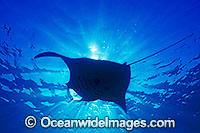
Manta ray Manta birostris silhouetted
in sunrays. |
|
Just north of Raine we dived a horseshoe
shaped reef with an unusually high number of sharks. During
a particular dive, several grey-whalers and silver-tips
persistently followed us everywhere and at times approached
within a couple of metres. At one stage I was concentrating
on a portrait shot and Meri pointed over my head. Not knowing
what to expect, I looked up and was relieved to see three
manta rays swimming in formation. The inquisitive sharks
continued to shadow us, and then joined several others schooling
under the boat. Later back on board Elizabeth E II someone
commented that during an unnerving deco stop on the shot-line,
they counted eighteen beauties around them!
Now the Pandora was just a few nautical
miles away and everyone was looking forward to our scheduled
dive the next day - we were the very first party of sport_
divers to be given special permission to dive this important
historic site. As there was no protection from the open
ocean we moved just inside the reef for the night. Peter
Gesner gave us a very informative slide show after dinner
and the whole fascinating saga of Pandora unfolded.
Having received his orders from the
Admiralty, Captain Edward Edwards sailed HMS Pandora from
Portsmouth on 7 November 1790 with a complement of 132 men.
His mission was to recapture HMS Bountv and hunt down Fletcher
Christian and his associates who had mutinied against Captain
William Bligh the previous year.
On 23 March 1791, the Pandora dropped
anchor in Tahiti's Matavai Bay and fourteen of the mutineers
were quickly rounded up. they were manacled and locked away
in "Pandora's Box", a makeshift prison built on
the ship's quarter deck. Fletcher Christian and eight associates
managed to escape Edward by setting off in the Bounty long
before the Pandora's arrival; their retreat on Pitcairn
Island remained undetected until 1808.
After spending a futile three months
searching most of the major Polynesian island groups west
of Tahiti for Christian and his counterparts, the Pandora
set course for Timor via the Torres Straits.
She reached the Great Barrier Reef on 26 August that same
year and proceeded in a southerly direction skirting the
outer edge in search of a safe passage. An opening was later
discovered on 18 August and a boat launched to find a clear
path through the reef; it was late in the day
when the boat signalled that one had been found. With dusk
approaching, Edwards considered the passage too dangerous
and decided it would be safer to hold out to sea until better
light the next morning. While the Pandora was manouvering
to pick up the boat, she ran aground on a submerged reef.
Aided by the rising tide she bounced
her way over the reef into deeper water. Men frantically
worked the pumps desperately attempting to save her but
all hopes were lost when one of the pumps broke down and
water quickly rose in the hold. At first light on 29 August,
Edwards gave the order to abandon ship and while in the
process of doing so, she foundered with the loss of 31 crew
and four prisoners.
The survivors spent a harrowing three
days on a nearby sand cay before setting off in four small
boats on a 1100 nautical mile journey for Timor. Although
not without hardship, the voyage was comparatively uneventful
and they managed to reach the Dutch East India Company (VOC)
at Coupang.
Today Pandora rests in a bed of sand
about 32 metres beneath the surface and is one of Australia's
best-preserved shipwreck sites. After three major archaeological
excavations carried out by the Queensland museum, it is
estimated about one-third of the hull still exists under
the sand.
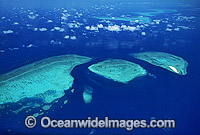
Aerial view of far northern Ribbon Reefs (above).
Aerial view of far 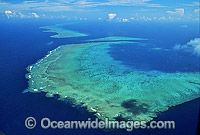 northern
Ribbon Reefs, showing Cod Hole and Cormorant
Pass (right). |
|
Descending, I wondered if the conditions
above were similar to those when she struck the reef; the
surface was in a turmoil and the sky smothered in black
cloud. The bottom quickly appeared and dark objects could
clearly be seen on the white sand. Directly below us was
a large anchor, possibly one of those used to steady Pandora
immediately after she was refloated from the reef and stacked
to one side were several of the Queensland Museum's excavating
grids.
A section of Pandora's sternpost protruding
from the sand a short distance away confirmed that we were
at the stern end. We moved around and quickly took some
pictures then headed to the bow section, passing over what
looked like a cannon among other heavily encrusted objects.
Standing alone on the seabed, about one metre tall, was
the iron Brodie stove from Pandora's galley, sparsely decorated
with a few featherstars and tunicates. We were delighted
to discover an anemone with a family of clownfish living
happily on the stove's upper surface as very little marine
life exists on the wreck site.
Our short bottom time soon ended and
as we slowly made our way back up the line, we watched a
second group of divers descend onto the wreck site.
With the Pandora behind us, we journeyed
inside the reef to Cape Grenville, then followed the coast
south to Princess Charlotte Bay where we took on extra fuel.
This gave everyone a welcome chance to stretch their legs
on nearby Stanley Island and after a pleasant short walk
through bush terrain, we reached some magnificent galleries
of Aboriginal rock paintings.
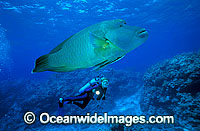
Diver with hump-head maori wrasse Cheilinus
undulatus (above).
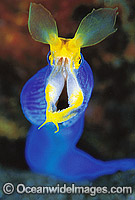
Blue ribbon eel Rhinomuraena quaesita
|
|
Continuing south we stopped off to
dive Mid, Waining and Hilder Reefs before eventually reaching
the world-famous Cod Hole in Cormorant Pass east of Lizard
Island. Even though it was my third visit to the Cod Hole,
I still couldn't get enough of the place. It is truly one
of the Great Barrier Reef's most magical dives. Feeding
the large potato-cod, about sixteen in all, is best left
to the experts; although they were extremely friendly, they
have appalling table manners. If a hand, or even camera
for that matter, happens to get in the way of a tasty morsel,
it's just bad luck! Everyone was relieved when Andrew (Critto)
plucked up courage and volunteered to do the feeding. He
did such a good job he even lured the two huge resident
morays out of their holes. He was totally oblivious to their
presence until members of our group frantically pointed
between his legs. One of the funniest sights I have ever
seen underwater was Andrew jumping almost clean out of his
crazy tiger-striped lycra suit in fright! Competing with
the cod for a free handout and just as friendly are the
resident humpheaded Maori-wrasse. They have grown tremendously
over the years and are now enormous, making ideal photographic
subjects. I know of no other place where numbers of these
spectacular fish can be approached at such close range.
After a pleasant shallow-water dive
with Lizard's giant tridacna clams we journeyed down to
Pixie Pinnacle at the southern end of Ribbon Reef No. 10.
It's another great location with incredible diving. It begins
one metre beneath the surface, then in pillar-form drops
sheer to about sixteen metres before tapering quickly down
to a sandy seabed another sixteen metres below. Although
the pinnacle can be circumnavigated in only a few minutes,
it would take many hours to explore its concentration of
marine life. On the flat "table-top" alone we
encountered two different species of clownfish, several
coral blennies and hawkfish. At the base of the coral pillar,
small soft corals, purple tunicates and colourful featherstars
decorate a sizeable ledge. Among the multitude of fish living
on and around the pinnacle are hundreds of tiny sergeant
major fish that delight in being handfed. And then there's
schooling barracuda, fusiliers and grey drummer.
With a few more Ribbon Reef dives tucked
under our belt, we continued on back to Cairns and the end
of our great adventure.
Text: Gary Bell
Photography: Gary Bell
|

